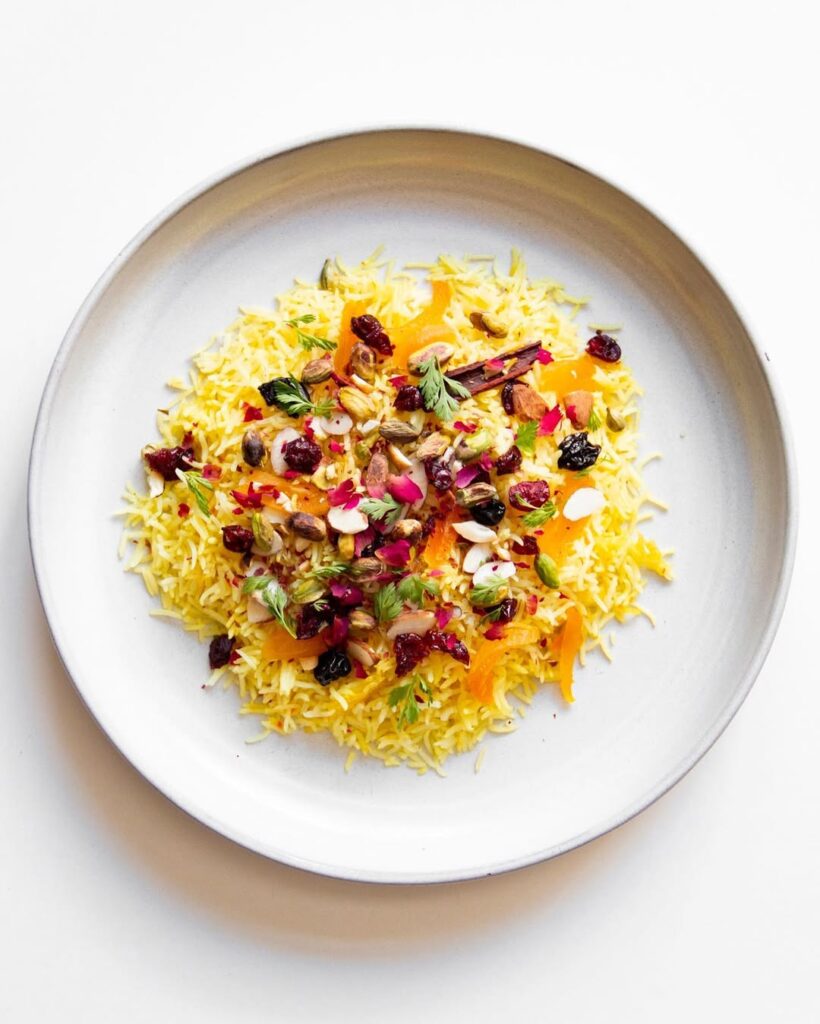Persian Jeweled Rice – A feast for both the eyes and the palate, Persian Jeweled Rice—known in Persian as javaher polo—is a dish that truly lives up to its regal name. Often served at weddings, Nowruz (Persian New Year), and other festive occasions, this vibrant rice dish symbolizes prosperity, joy, and abundance. Each ingredient shines like a gem—saffron-golden rice, ruby-like barberries, emerald pistachios, and amber-colored orange peels—coming together to create a symphony of flavors and colors.

Recipe Overview
Prep Time: 25 minutes
Active Time: 45 minutes
Resting Time: 10 minutes
Cuisines: Persian / Middle Eastern
Course: Main Course / Side Dish
Servings: 6
Calories: 480 kcal per serving
Total Time: 1 hour 20 minutes
Equipment Needed
-
Large saucepan or rice cooker
-
Nonstick skillet
-
Small saucepan (for saffron water)
-
Fine mesh strainer
-
Mixing bowls
-
Wooden spoon or spatula
Ingredients
For the Rice:
-
2 cups basmati rice
-
4 cups water
-
2 tablespoons salt (for soaking)
-
3 tablespoons unsalted butter or ghee
-
1 teaspoon saffron threads, crushed and steeped in 2 tablespoons hot water
For the Jeweled Topping:
-
½ cup slivered almonds
-
½ cup pistachios, sliced
-
½ cup orange peel, finely julienned (candied or fresh, blanched and simmered)
-
½ cup barberries (zereshk), rinsed and soaked in warm water
-
¼ cup golden raisins
-
¼ cup chopped dried apricots
-
2 tablespoons sugar
-
3 tablespoons butter or ghee
-
½ teaspoon ground cinnamon
-
¼ teaspoon ground cardamom
-
¼ teaspoon ground cumin
-
Salt, to taste
Nutrition Information
| Nutrient | Amount (per serving) |
|---|---|
| Calories | 480 kcal |
| Carbohydrates | 72 g |
| Protein | 8 g |
| Fat | 17 g |
| Saturated Fat | 4 g |
| Fiber | 5 g |
| Sugar | 12 g |
| Sodium | 400 mg |
| Cholesterol | 10 mg |
Instructions
Step 1: Prepare the Rice
Rinse the basmati rice under cold water until the water runs clear. Soak it in salted water for about 30 minutes, then drain.
In a large saucepan, bring 4 cups of water to a boil. Add the rice and cook for 5–6 minutes, just until slightly tender but not fully cooked (al dente). Drain the rice and set aside.
Step 2: Make the Saffron Water
In a small bowl, mix the crushed saffron threads with 2 tablespoons of hot water. Allow it to steep for 5–10 minutes, releasing its deep golden hue and aroma.
Step 3: Prepare the Candied Orange Peel
If using fresh orange peel, blanch it twice in boiling water to remove bitterness, then simmer it in 1 cup of water with 2 tablespoons of sugar until slightly softened. Drain and set aside. This gives the dish a fragrant citrus note that balances the richness of the rice and nuts.
Step 4: Cook the Jeweled Fruits and Nuts
In a skillet, melt the butter or ghee over medium heat. Add almonds and pistachios, toasting them until lightly golden. Add the barberries, raisins, apricots, and orange peel. Sprinkle in sugar, cinnamon, cardamom, and a pinch of cumin. Sauté gently for 3–5 minutes until the fruits are plump and glistening, then remove from heat.
Step 5: Steam the Rice
In a large nonstick pot, melt 2 tablespoons of butter. Add a spoonful of the cooked rice to cover the bottom of the pan (this helps create the crispy tahdig—the golden crust). Then layer the rest of the rice, alternating with small portions of the jeweled mixture.
Drizzle the saffron water evenly over the top of the rice. Cover the pot with a clean kitchen towel (to absorb steam) and then place the lid securely on top.
Steam on low heat for 25–30 minutes. The rice will absorb the saffron, turn golden, and develop a crisp bottom layer.
Tips for Perfect Persian Jeweled Rice
-
Use long-grain basmati rice: Its light, fluffy texture is essential for achieving the proper look and mouthfeel.
-
Don’t overcook the rice: Parboiling before steaming ensures each grain stays separate.
-
Soak and rinse the rice well: This removes excess starch, preventing clumping.
-
Balance the sweetness and tartness: Adjust sugar or barberries according to taste preferences.
-
Create a beautiful tahdig: The crispy crust at the bottom adds both texture and visual appeal.
-
Use real saffron: It’s the key ingredient that gives the dish its signature aroma and color.
Conclusion
Persian Jeweled Rice is more than just a meal; it’s a work of art and a symbol of celebration. With its radiant colors, aromatic spices, and exquisite balance of flavors, it brings warmth and joy to every table. This dish embodies the generosity and sophistication of Persian culture, where food is not merely nourishment but an expression of love and hospitality.
